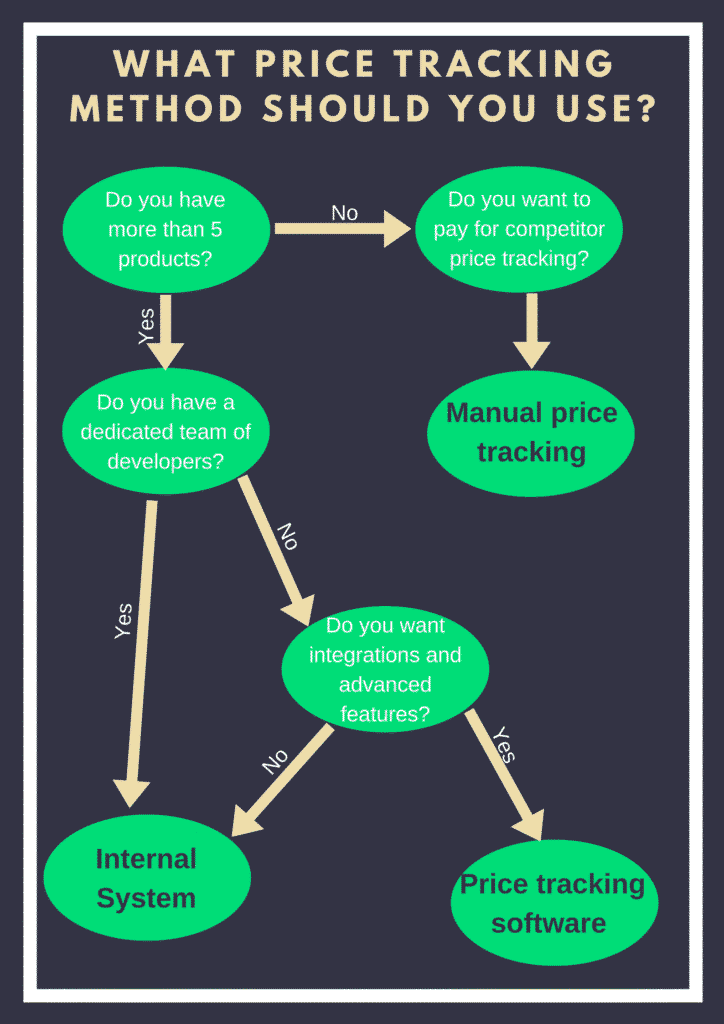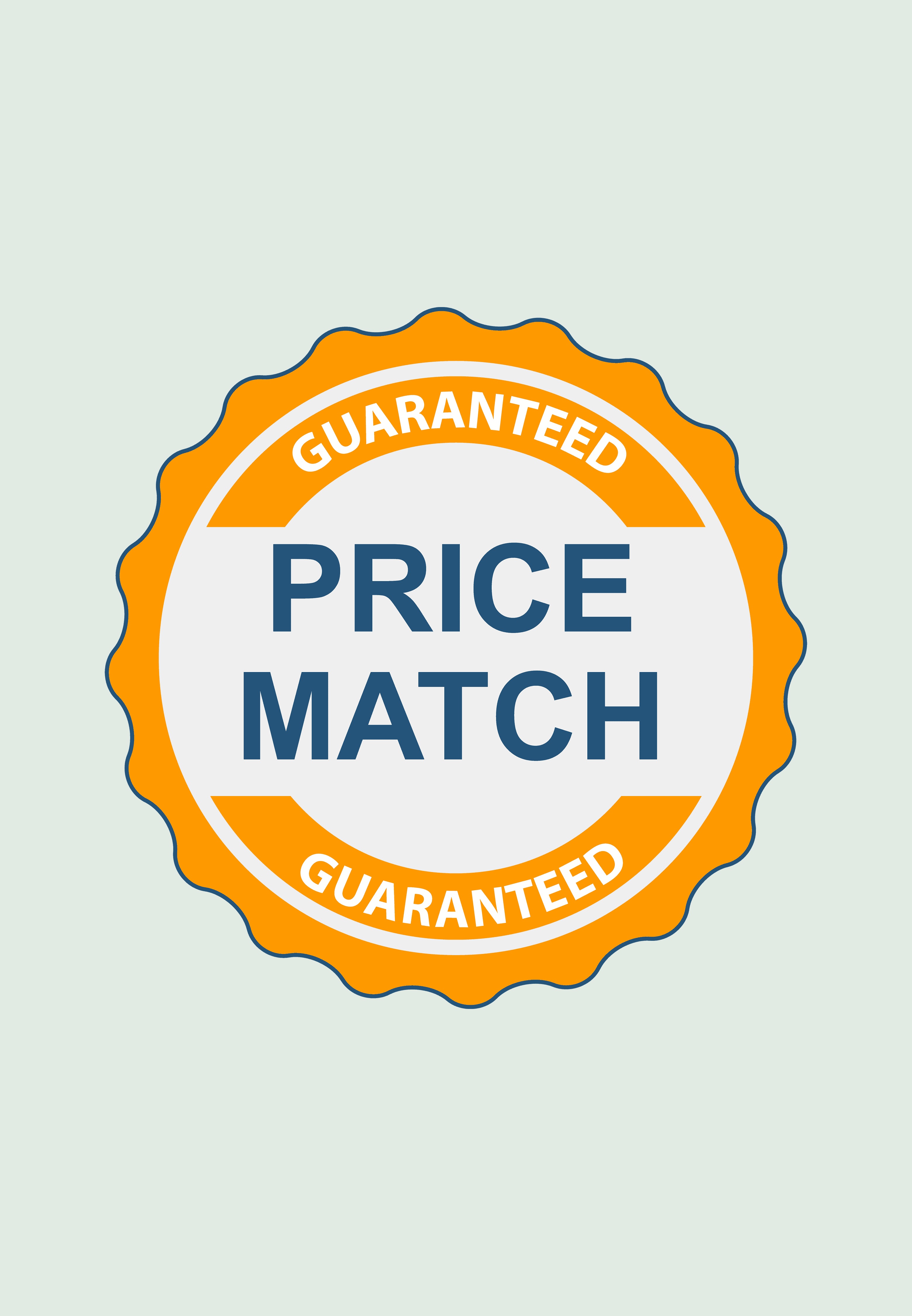Now more than ever consumers can choose where and who they purchase from. To keep up with your potential customers and current competitors, you need to find some way to start price monitoring. This will allow you to become more competitive with your offerings and ensure you’re generating enough profit to keep your business afloat.
But how do you decide how you should monitor your competitor’s prices? There are three core methods we want to talk about in this blog:
- Manual tracking
- Building your own in-house system
- Competitor price monitoring
When it comes to price tracking, you have a number of options available to you. Some more expensive than the others, but some, more effective than the others.
In this blog post, we’re going to walk you through the pros and cons of each method of manual price tracking to help you decide which method is best for you.
Choosing the right competitor price tracking method
Despite which e-commerce sector you’re part of, you’ll be part of the community who at some point have to change your prices, whether that is to keep up with your competition or offer discounts for events such as holidays or Black Friday.
But it’s hard to know which method will be right for you.
Use the following infographic flowchart below to help you understand what method of price tracking is right for your business.

Manual Price Tracking
Automation is key. Depending on your e-commerce store, you might have a load of products. A load of products means a load of prices. Manually tracking each product’s price on your competitor’s website is both time consuming and a waste of decision-makers time.
The first thing to question is just how much time do you spend tracking your competitor’s prices? Is it a task you do weekly? Monthly? Or, perhaps even daily.
For those with few competitors and few products, it might be easier to do the competitor price tracking yourself.
If you have more than about 20 products, it’s probably time to start automating the process as doing competitive research on a daily basis manually is a waste of your time that could be spent developing other areas of the business.
The benefit of using a SaaS e-commerce price comparison tool like Prisync is the ability to let the system gather the data you need, as opposed to doing it manually yourself.
If you want a solution to manually track your competitor’s pricing, the best tool would probably be a spreadsheet. This way you can keep all the data in one location. However, as far as things go this is a time-consuming task and limits the effectiveness of what you hope to achieve with your competitor price tracking exercise.
We don’t recommend manually price tracking for e-commerce stores that have multiple products.
Let’s look at how this would manifest. Suppose in your store you have 50 products. You also do a quick google search to find your top 10 competitors. The questions you have to ask yourself then are:
- How often are you supposed to check their prices?
- If it’s every day, then you need to check 500 price points a day. That’s a lot of work for anyone, nevermind a time-strapped e-commerce worker.

In-house price tracking system
If you want to dynamically change your prices in accordance with market trends, then you need to get proactive, rather than reactive with your competitor price tracking and automate the entire process.
You might think the best way to do this is through an internal price tracking system you build yourselves. But the issue is internal issues are problems like HR or finance. Competitive price tracking is an external issue, especially with the growing number of e-commerce marketplace available to sell products.
If you do want to use an in-house system, then you should think carefully about whether you have the manpower and financial stability to do so. Not only will you need a dedicated software developer to build and maintain the tool, you’ll also need to factor in their salary and server costs.
You might have a team of developers at hand already, able to work on building your in-house software. However, what people often don’t take into account is the number of advanced features that typical SaaS competitive price tracking solutions offer.
Because your developers will be working on a number of other tasks at the same time, they might not have the time to build an advanced tool and so instead, you’ll have to settle for a tool that limits your abilities to efficiently track your competitor’s pricing.
For example, if you were to use a price tracking tool like Prisync you’d be able to make use of stock availabilities of competitors, historical index chart, advanced reports, category/brand performance analytics, customizable email alerts, MAP monitoring.
Competitor price monitoring software
Automated SaaS competitor price tracking solutions are ideal for those who want to consistently be able to see when a competitor has raised or lowered their price, across a number of different channels. It’s a super scalable way to run the systems and gives your team time to work on things that are more important to them.
Informed decisions are always backed by data. Using an automated competitor price tracking software will provide you with access to that data, so that you can become proactive, rather than reactive.
In most cases, you’re dealing with real-time data, which also means real-time pricing.

You don’t have to worry about accuracy. By their very nature, humans make errors. It might happen once a week, but it also could happen every day and in some cases, could lead to drastic problems in your business if someone manually writes a price decrease from 100 to 1 rather than 100 to 10.
So while an out of the box system might seem like a monthly expense you could do without, think about the cost of hiring the team to actually manually update the prices.
Benefits of Competitor Price Monitoring Software takeaways
What if you don’t want to check your competitor’s prices? For some products that you might sell on your e-commerce store, there will be no need for any price comparison tracking software. This is only the case when dealing with distinguished products that are well differentiated from their competitors.
They no longer need to join the race to the bottom because their different factors actually mean something to the customer and henceforth, they get customers without having to deal with pricing battles or wars.
The issue is, with how the e-commerce world is becoming so saturated, it’s no longer enough to just track one competitor. Your competitors are on social media, they’re on marketplaces like Amazon, they’re on their own websites.
They’re everywhere. And if you want to have a good grasp of market trends, you need to analyze the data. Instead of spending time and resources collecting that data yourself, using an off-the-shelf system will enable you to focus on the parts of your business that you’re good at.
It will give you a clearer understanding of how your market is changing by giving you a wide view of your competitor’s pricing activities.
You’ll then be able to adjust your own pricing strategy in accordance with the market trends.
pricing strategies


Leave a Reply